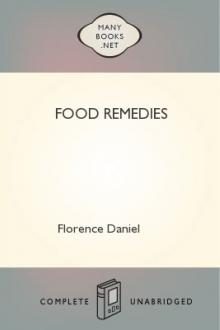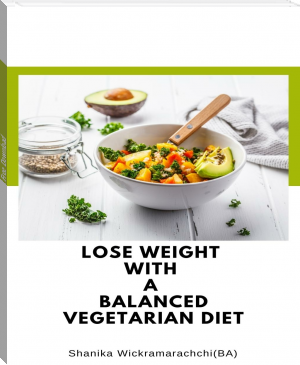The Chemistry of Food and Nutrition, A. W. Duncan [i love reading .txt] 📗

- Author: A. W. Duncan
- Performer: -
Book online «The Chemistry of Food and Nutrition, A. W. Duncan [i love reading .txt] 📗». Author A. W. Duncan
Pulse, or Legumes, includes haricots and other beans, peas and lentils. The proteid contained is that variety known as legumin, which is either the same, or is closely allied, to the casein of milk and cheese. Pulse is very rich in proteid, the dried kinds in general use, contain 24 or 25 per cent. The richest is the soy-bean, which is used in China and Japan, it contains 35 per cent., besides 19 per cent. of fat. Pulse requires thorough cooking, haricots taking the longest time. Split lentils are cooked sooner, and are better digested; this is chiefly due to the removal of the skins. The haricots, bought from small grocers who have a slow sale, are often old, and will not cook tender. Pulse is best adapted to the labouring classes; the sedentary should eat it sparingly, it is liable to cause flatulence or accumulation of gas in the intestines, and constipation. Haricots are easier to digest when mashed and mixed with other food. Pulse was formerly stated to leave much undigested residue. Recent experiments have shown that it is satisfactorily digested under favourable conditions. Strümpell found beans in their skins to leave a large proportion of proteid matter unabsorbed. Lentil meal mixed with other food was digested in a perfectly satisfactory manner. Another experimenter (Rubner) found that when even the very large quantity of 1-1/8 pound of dried split peas per day were eaten, only 17 per cent. of proteid matter was unabsorbed, which compares very well with the 11 per cent. of proteid left from a macaroni diet, with which the same man was fed at another time. Had a reasonable quantity of peas been eaten per day, the quantity undigested would probably have differed little from that of other foods.
Nuts are, as a rule, very rich in oil and contain a fair proportion of proteid; when well masticated they are a very valuable food. Walnuts are one of the best, and the kernels can be purchased shelled, thus avoiding much trouble. They can be finely ground in a nut-mill and used for several purposes, mixed in the proportion of about two ounces to the pound of wheatmeal they produce a rich flavoured bread. They can also he used in sweet cakes and in rich puddings to increase their food value, lightness and taste. Pine kernels being very oily, can be used with flour in the place of lard or butter.
Fruits are generally looked upon as luxuries, rather than as food capable of supplying a meal or a substantial part of one. They are usually eaten only when the appetite has been appeased by what is considered more substantial fare. Fresh fruits contain a larger proportion of water than nearly all other raw foods, and consequently the proportion of nourishment is small; but we must not despise them on this account. Milk contains as much or more water. Certain foods which in the raw state contain very little water, such as the pulses and cereals when cooked absorb a very large quantity; this is particularly the case in making porridge. Cabbage, cauliflower, Spanish onions and turnips, after cooking contain even 97 per cent. of water. Roast beef contains on an average 48 per cent., and cooked round steak with fat removed 63 per cent. of water. It is customary at meal times to drink water, tea, coffee, beer, wine, &c. When a meal contains any considerable quantity of fresh fruits there need be no desire to drink. Notwithstanding that fruits contain so much water, a dietary consisting of fruits with nuts, to which may be added bread and vegetables, will contain less water than the total quantity usually consumed by a person taking the more customary highly cooked and seasoned foods. An advantage is that the water in fruits is in a wholesome condition, free from the pollution often met with in the water used for drinking purposes. Raw fruits favour mastication, with its consequent advantages, whilst cooked and soft food discourages it. Plums and what are termed stone fruits, if eaten in more than very small quantities, are apt to disagree. Persons with good digestions can take fruit with bread, biscuits and with uncooked foods without any inconvenience. Fruit is more likely to disagree when taken in conjunction with elaborately cooked foods. Many cannot take fruit, especially if it be acid, at the same time as cereal or starchy substances, and the difficulty is said to be greater at the morning's meal. If the indigestion produced is due to the acid of the fruit preventing the saliva acting on the starch, scientific principles would direct that the fruit be eaten quite towards the end of the meal. The same consideration condemns the use of mint sauce, cucumber and vinegar, or pickles, with potatoes and bread, or even mint sauce with green peas. Bananas are an exception, as not interfering with the digestion of starch. Bananas are generally eaten in an unripe condition, white and somewhat mealy; they should be kept until the starch has been converted into sugar, when they are both more pleasant and wholesome. Nuts and fruit go well together. For a portable meal, stoned raisins or other dried fruit and walnut kernels or other nuts are excellent.
What has been called a defect in most fruits, is the fact that the proteid is small in proportion to the other constituents. This has been too much dwelt upon, owing to the prevailing exaggerated idea of the quantity of proteid required. The tomato contains a large proportion, though the water is very high. Bananas, grapes and strawberries contain to each part of proteid from 10 to 12 parts of other solid nutritive constituents (any oil being calculated into starch equivalents); this is termed the nutritive ratio. Although this may seem a small proportion of proteid, there are reasons for believing that it is sufficient. Taking the average of 29 analyses of American apples, a nutritive ratio of 33 was obtained. If it were suggested that life should be sustained on apples alone, this small quantity of proteid would be an insurmountable difficulty. As the addition of nuts or other nutritious food sufficiently increases the proteid, no objection can with justice be made against the use of fruit. A study of our teeth, digestive organs and general structure, and of comparative anatomy, points to fruits, nuts and succulent vegetables as our original diet.
The potash and other salts of the organic acids in fruits tend to keep the blood properly alkaline. Where there is a tendency to the deposition of uric acid in the body, they hinder its formation. Citric, tartaric, malic and other organic acids exist in fruits in combination with potash and other bases, as well as in the free state. The free acids in fruits, when eaten, combine with the alkalies in the intestinal tract, and are absorbed by the body and pass into the blood, not as acids, but as neutral salts. Here they are converted into potassium carbonate or some other carbonate. Fruit acids never make the blood acid but the reverse. Fruit salts and acids are antiscorbutic. Fruits have often proved of the greatest benefit in illness. What is known as the grape cure has been productive of much good. Lemons and oranges have also been of great benefit. Strawberries have been craved for and have proved of the greatest advantage in some extreme cases of illness when more concentrated food could not be endured. Fruit is coming into greater use, especially owing to its better distribution and lessened cost. Fruit is not as cheap as it should be, as it can be produced in great abundance at little cost, and with comparatively little labour. The price paid by the public greatly exceeds the real cost of production. A very large proportion, often the greater part of the cost to the consumer, goes in railway and other rates and in middle-men's profits. It is commonly cheaper to bring fruit from over the sea, including land carriage on either side, than it is to transport English produce from one part of our country to another. English homegrown fruit would be cheaper were it not for the difficulty of buying suitable land at a reasonable price, and the cost of transit. For the production of prime fruit there is a lack of sufficient intelligence, of scientific culture and co-operation.
Vegetables—using the name in its popular sense—contain valuable saline constituents or salts. By the usual method of cooking a large proportion of the salts is lost. It is better to steam than to boil them. The fibrous portion of vegetables is not all digested, but it is useful in stimulating the peristaltic action of the bowels and lessening any tendency to constipation. Vegetables are more especially useful to non-vegetarians to correct the defects of their other food.
The potato belongs to a poisonous order—the Solanacæ. There is a little alkaloid in the skin, but this is lost in the cooking. The eyes and sprouting portions contain the most and should be cut out.
Fungi.—There are about a hundred edible species in this country, but many of the fungi are poisonous, some intensely so. It can scarcely be expected that these lowly organised plants, differing so much in their manner of growth from the green or chlorophyll bearing plants, can be particularly nourishing. It is only the fructifying part, which appears above the ground, that is generally eaten. It is of very rapid growth. Of 9 edible fungi of 4 species, obtained in the Belgrade market, the average amount of water was 89.3 per cent., leaving only 10.7 per cent. of solid matter; the average of fat was 0.55 per cent. The food value of fungi has been greatly over-rated. In most of the analyses given in text-books and elsewhere, the total nitrogen has been multiplied by 6.25 and the result expressed as proteid. The amount of nitrogen in a form useless for the purpose of nutrition is about a third of the whole. Of the remainder or proteid nitrogen, it is said much is not assimilated, sometimes quite half, owing to the somewhat indigestible character of the fungi. An analysis of the common mushroom gave proteids 2.2 per cent., amides (useless nitrogenous compounds) 1.3 per cent., and water 93.7 per cent. The fungi are of inferior nutritive value to many fresh vegetables and are much more expensive. Their chief value is as a flavouring.
Milk and Eggs are permissible in a vegetarian dietary, and as a rule, vegetarians use them. Eggs, with the exception of such as are unfertile, are of course alive; but they have no conscious existence, and cannot be said to suffer any pain on being killed and eaten. An objection to their use as food is, that on an egg and poultry farm, the superfluous male birds are killed, and as the hens become unprofitable layers they are also killed. A similar humane objection applies to the use of cow's milk by man. The calves are deprived of part of their natural food, the deficiency being perhaps made up by unnatural farinaceous milk substitutes. Many of the calves, especially the bull calves, are killed, thus





Comments (0)